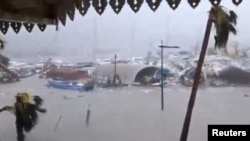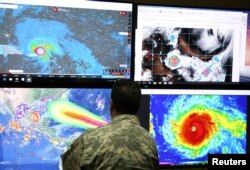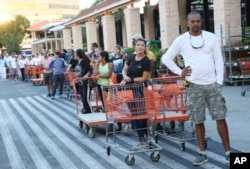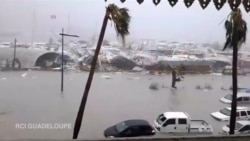The Caribbean island of Barbuda is isolated after taking a direct hit from Hurricane Irma, the strongest Atlantic storm in recorded history.
There is no power on Barbuda and no way to communicate with the outside world.
Meanwhile, French President Emmanuel Macron said he expected the toll Irma took on the French West Indies, including St. Martin and St. Barts, to be "harsh and cruel," with considerable casualties and damage.
Puerto Rico was next in Irma's path. High winds and rain began to lash the island late Wednesday afternoon.
The U.S. territory is in the middle of a financial crisis, and officials there said it could take as long as six months to restore electricity to the entire island if power was knocked out.
The U.S. National Hurricane Center predicted what it called the "extremely dangerous core" of Irma will pass over Puerto Rico's northern coast Wednesday night on its way to the Dominican Republic and Haiti.
Irma's power is breathtaking. It is a Category 5 storm, the highest on the wind scale. It had top sustained winds of 295 kph (183 mph). Forecasters said they did not expect it to fall below a Category 4 storm as it moved along its forecast path toward Florida.
Irma was predicted to strike southern Florida and the Miami area by Sunday, though an exact forecast was nearly impossible to nail down.
Florida Governor Rick Scott told people to prepare now and not ignore any mandatory evacuation orders. He said the storm was likely to affect the entire state.
"You can rebuild your homes, but you cannot rebuild your life," Scott said.
The Florida Keys were already under a mandatory evacuation order. People were finding long lines at gas stations that still had fuel. Anyone entering a southern Florida supermarket was finding more empty shelves than full ones.
The governor said stores were working as hard as they could to restock supplies, especially bottled water.
WATCH: Caribbean Island Nations, Florida Brace for Hurricane Irma
Forecasters said Irma could bring storm surges of 2 to 6 meters (6½ to more than 19½ feet) and as much as 50 centimeters (nearly 20 inches) of rain on top of its fierce winds.
Scott said the storm was worse than Hurricane Andrew, he 1992 storm that turned entire Miami neighborhoods into empty lots.
Some longtime Florida residents who stayed put for Andrew and other powerful storms said they were not going to take any chances with Irma.
President Donald Trump declared states of emergency in Florida, Puerto Rico and the Virgin Islands. He ordered the Federal Emergency Management Agency to begin relief efforts even while it was still helping southeastern Texas clean up from last month's Category 4 Hurricane Harvey.
Hurricanes need tropical water for fuel, and Irma's power is coming from the unusually warm waters in the Atlantic.
Meanwhile, forecasters have their eyes on two other hurricanes.
Hurricane Jose is a Category 1 storm east of the Lesser Antilles and still far from land.
Hurricane Katia is also a Category 1, in the southwestern Gulf of Mexico, prompting authorities to issue a hurricane watch for the coast of Veracruz, Mexico.
Experts called the formation of three simultaneous Atlantic hurricanes extremely rare.













